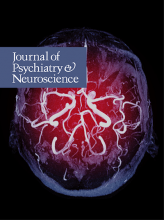A 72-year-old man with a longstanding history of bipolar affective disorder type 1 had been stable on lithium monotherapy of 900 mg/night at a serum level of 0.8 mmol/L for more than 20 years. His family physician started him on hydrochlorothiazide (12.5 mg/d) for hypertension. One week later, the patient’s wife noticed unsteady gait, slurred speech and somnolence. The patient was brought to the emergency department, where he was found to have a lithium level of 1.7 mmol/L, a sodium level of 147 mmol/L, and an estimated glomerular filtration rate (eGFR) of 25 mL/min/1.73 m2. While admitted to hospital for an acute kidney injury (AKI), the patient was switched to valproate. The AKI and neurologic sequelae resolved with hydration, and his renal function returned to his baseline 65 mL/min/1.73 m2 within a year. In the years that followed, the patient was continued on valproate, but he experienced several depressive and hypomanic relapses.
Lithium toxicity is common in older users, with an annual incidence of 1.5% per year.1 Severe toxicity primarily manifests with neurologic sequelae (coarse tremor, gait difficulties, delirium, seizures, somnolence) and sometimes cardiac dysrhythmias.2 In addition, AKI and acute renal toxicity occur in 1.3%–4% of older lithium users over 5-year follow-up.3 These acute neurologic and renal manifestations generally resolve completely within 9–12 months,2,4 although sometimes renal impairment may be sustained.3
Toxicity symptoms are common at levels higher than 1.5 mEq/L, although chronic lithium intoxication at levels above 0.8mEq/L may also be dangerous in older adults.4 Natural aging also increases the risk for toxicity; the lithium dose required to achieve a given therapeutic serum level may decrease three-fold between the ages of 40 and 95 years, largely owing to decreased eGFR.5 Consequently, lithium and renal function need monitoring every 3 months with aging.4,5 Nephrogenic diabetes insipidus also increases toxicity risk, possibly through a feedback loop of elevated lithium levels causing acute diabetes insipidus and leading to further diuresis and lithium level elevations.6 Other risk factors include medications commonly prescribed in late life, such as diuretics, loop diuretics, angiotensin converting enzyme inhibitors, angiotensin II receptor blockers and nonsteroid anti-inflammatory drugs, which can increase lithium levels up to 50%.1
Despite the relatively low 0.5%–2% risk of serious long-term sequelae of lithium use,7 acute toxicity frequently leads to lithium discontinuation and rates of mood disorder relapse of 33%–50%.5,8 The potential for acute toxicity has led many clinicians to avoid prescribing lithium for older adults and choose agents, such as valproate,9 even though cognitive dysfunction and dementia rates may be worse with valproate.10 Whether lithium increases the long-term risk of chronic kidney disease11 remains unclear. It is true that 0.5%–2% of patients may eventually require chronic dialysis and that continued lithium exposure can be associated with accelerated renal decline in older adults with premorbid eGFR lower than 60 mL/min/1.73 m2.12 However, renal decline does not appear to exceed normal aging in most older adults treated with lithium levels below 0.8 mmol/L, particularly at levels below 0.5 mmol/L.13 Aging, diabetes, hypertension and heart disease14 account for most renal dysfunction seen in patients with mood disorders.15
In this clinical vignette, the recent initiation of hydrochlorothiazide likely led to a cascade of events: increased lithium level, acute nephrogenic diabetes insipidus, dehydration, AKI and reduced renal clearance, leading to further lithium level increases.6 In this case, permanent renal4 and neurologic damage are unlikely.2 The patient also had a history of poor psychiatric course following lithium discontinuation. Considering that 30%–40% of patients with bipolar disorder are preferential lithium responders16 and that lithium can potentially prevent suicide, a retrial of lithium may be beneficial in our patient’s case especially because lithium responders often do not respond to other treatments. Careful titration of lithium, caution about drug interactions (e.g., diuretics), and regular lithium and renal (eGFR) monitoring can help prevent further toxicity episodes in older adults.6
Footnotes
The information in this column is not intended as a definitive treatment strategy but as a suggested approach for clinicians treating patients with similar histories. Individual cases may vary and should be evaluated carefully before treatment is provided. The patient described in this column is a composite with characteristics of several real patients.
Competing interests: None delcared.









